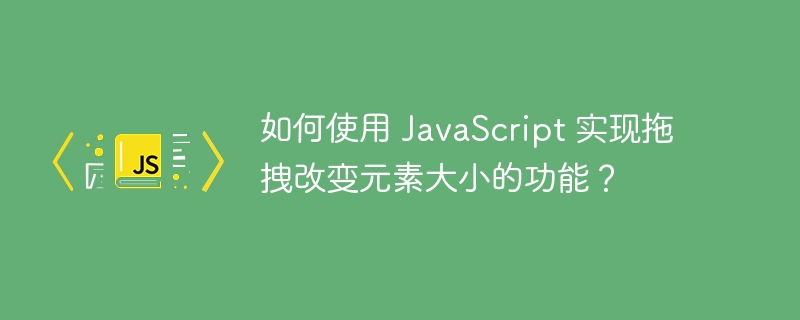Home >Web Front-end >JS Tutorial >How to use JavaScript to implement the function of dragging and dropping to change the size of elements?
How to use JavaScript to implement the function of dragging and dropping to change the size of elements?
- WBOYWBOYWBOYWBOYWBOYWBOYWBOYWBOYWBOYWBOYWBOYWBOYWBOriginal
- 2023-10-21 11:34:511451browse

How to use JavaScript to implement the function of dragging and dropping to change the size of elements?
With the development of web technology, more and more web pages need to have the function of dragging and dropping to change the size of elements. For example, you can drag and resize a div element to adjust its width and height. This article explains how to implement this functionality using JavaScript and provides specific code examples.
Before we start, we need to understand some basic concepts:
-
The position and size attributes of elements:
In CSS, through top, left, width, and height attributes to specify the position and size of the element. We can use
element.stylein JavaScript to get or set the values of these properties. -
Event monitoring and processing:
JavaScript can listen to mouse events, such as mousedown, mousemove and mouseup events. We can use the
element.addEventListenermethod to bind these events to elements and specify the corresponding handler functions.
Now, we can start writing code. The following is a simple example that demonstrates how to use JavaScript to implement the function of dragging and changing the size of an element:
<!DOCTYPE html>
<html>
<head>
<style>
#resizeable {
width: 200px;
height: 200px;
border: 1px solid black;
}
</style>
</head>
<body>
<div id="resizeable"></div>
<script>
// 获取需要操作的元素
var resizeable = document.getElementById("resizeable");
// 定义标记变量
var isResizing = false;
var startX, startY;
// 绑定鼠标按下事件
resizeable.addEventListener("mousedown", function(event) {
// 记录起始位置
isResizing = true;
startX = event.clientX;
startY = event.clientY;
// 阻止默认的鼠标选择行为
event.preventDefault();
});
// 绑定鼠标移动事件
resizeable.addEventListener("mousemove", function(event) {
// 如果不是在拖拽中,直接返回
if (!isResizing) return;
// 计算鼠标移动的距离
var deltaX = event.clientX - startX;
var deltaY = event.clientY - startY;
// 更新元素的大小属性
resizeable.style.width = (resizeable.offsetWidth + deltaX) + "px";
resizeable.style.height = (resizeable.offsetHeight + deltaY) + "px";
// 更新起始位置
startX = event.clientX;
startY = event.clientY;
});
// 绑定鼠标释放事件
resizeable.addEventListener("mouseup", function() {
// 标记结束拖拽
isResizing = false;
});
</script>
</body>
</html>In the above code, a div element with the id of "resizeable" is defined through CSS and set its initial width and height. The JavaScript part is used to bind mouse events and update the element's size property in the event handler.
In the mouse down event, the starting position is recorded and the default mouse selection behavior is prevented. In the mouse move event, the size increment is calculated based on the distance moved by the mouse, and the element's size property is updated. Finally, in the mouse release event, mark the end of dragging.
Through the above code, we can implement a simple drag-and-drop function to change the size of elements. Further optimization and expansion can be carried out according to actual needs, such as limiting the minimum and maximum sizes, adding animation effects, etc.
I hope this article will help you understand and implement the function of dragging and dropping to change the size of elements!
The above is the detailed content of How to use JavaScript to implement the function of dragging and dropping to change the size of elements?. For more information, please follow other related articles on the PHP Chinese website!

